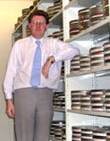|
|
 
|
|
Author
|
Topic: "contact printer"
|
|
|
|
|
|
|
Leo Enticknap
Film God

Posts: 7474
From: Loma Linda, CA
Registered: Jul 2000
|
 posted 08-14-2004 07:20 PM
posted 08-14-2004 07:20 PM





For info (Stephen - obviously this isn't news to John or Gordon), contact printing is one of two basic ways of copying a photographic image from one film to another. The other is 'optical' printing, in which the image of the source film is projected through a lens onto the destination raw stock in order to make the exposure.
Copying is always done using contact printing if possible, because by placing the source and destination elements in physical contact with each other, you'll get the best quality copy possible. With optical printing, the lens used to produce the image which exposes the raw stock will always introduce some distortion, however high quality that lens is. There are some cases, however, in which contact printing is impossible - for example if you need to copy one film gauge to another (e.g. blowing up 16mm to 35mm), introduce optical special effects or if an archive needs to copy a significantly shrunk original onto new, unshrunk duplicating stock.
Both contact and optical printers are further subdivided into two types: 'continuous' and 'step'. In a continuous printer, the source and destination films move constantly past an aperture or lens. A step printer has an intermittent mechanism, like a projector, and the duplicate is exposed frame by frame. Optical step printers are often used to photochemically copy archival elements which are in a very bad state indeed - usually severely shrunk or brittle.
It might be that digital intermediate processes will gradually reduce the need for optical duplication over time, and within a few years the only photochemical duplication which happens on any significant scale will be release printing using high-speed continuous contact printers. I recently sent a 1930s 16mm Dufaycolor film to a lab for enlargement to 35mm preservation elements and a print. We're having the preservation elements done photochemically, mainly because getting them scanned at 2k and a 35mm preservation negative output from there on a laser film recorder would be roughly twice the cost. I wouldn't be surprised if I place a similar order in a couple of years time, and find that the digital intermediate route is just as cheap, if not cheaper.
| IP: Logged
|
|
|
|
|
|
All times are Central (GMT -6:00)
|
|
Powered by Infopop Corporation
UBB.classicTM
6.3.1.2
The Film-Tech Forums are designed for various members related to the cinema industry to express their opinions, viewpoints and testimonials on various products, services and events based upon speculation, personal knowledge and factual information through use, therefore all views represented here allow no liability upon the publishers of this web site and the owners of said views assume no liability for any ill will resulting from these postings. The posts made here are for educational as well as entertainment purposes and as such anyone viewing this portion of the website must accept these views as statements of the author of that opinion
and agrees to release the authors from any and all liability.
|

 Home
Home
 Products
Products
 Store
Store
 Forum
Forum
 Warehouse
Warehouse
 Contact Us
Contact Us




 Printer-friendly view of this topic
Printer-friendly view of this topic












